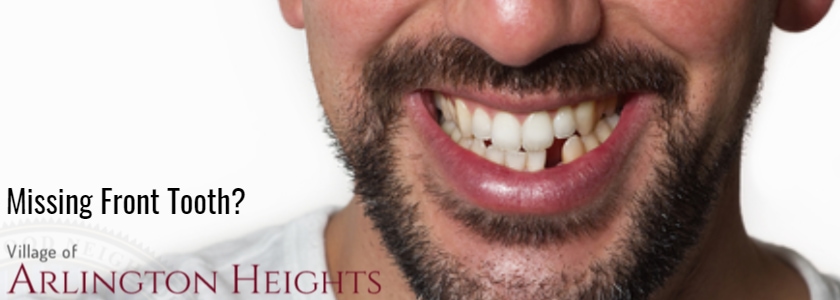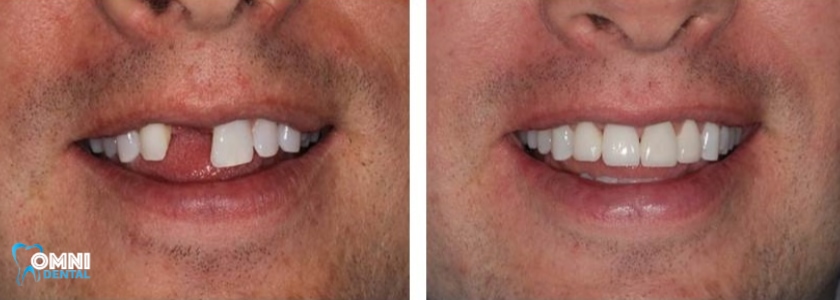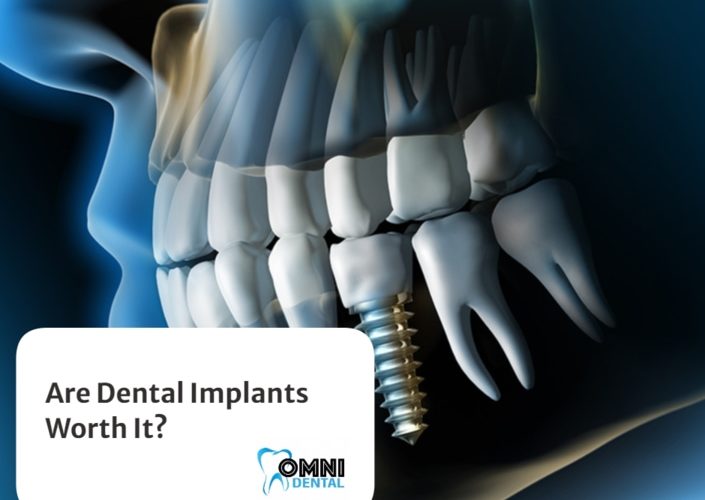In the U.S., less than half of all adults have all their permanent teeth. As people get older, the chance they may be missing at least one tooth grows. Unfortunately Two-thirds of adults between the ages of 40 and 64 are missing at least one tooth. Around 19% of adults over the age of 65 are edentulous and need immediate dental care, meaning they are missing all their natural teeth. Among the most common reasons for tooth loss in adults is untreated dental cavities or tooth decay.
Bonding
If you only have a small crack or chip and the rest of your tooth is in good condition (not requiring a root canal or extraction), your dentist may be able to bond your tooth. If your dental professional recommends this treatment, they will mold a composite material to cover the crack or chip. Then they will cure it to mimic the hardness of your natural tooth enamel. Bonding can last for five to ten years.
Front Tooth Dental Implant
Implants are a great way to replace teeth that have fallen out due to gum disease. Implants replace the roots of lost teeth, and that preserves the patient’s jawbone. It prevents their facial appearance from changing because of their jawbone deteriorating due to missing teeth.
When you have a dental implant, a titanium alloy implant post is inserted directly into your jawbone. This is a small surgical procedure that can be completed here in Omni Dental by our dentist, Dr. Bilus Poles. If you do feel nervous, we can discuss using additional sedation, but it generally takes less than an hour to insert a single dental implant.
Although a crown-&-bridge or partial can replace a missing tooth or teeth, they do not replace the presence of a tooth root. Dental implants are able to do this, halting the repercussions of bone loss.
Main Dental Implant Benefits:
- They are durable and permanent
- Minimal maintenance is required other than good oral hygiene and professional dental checkups and cleanings
- Feel natural and comfortable and provide the best aesthetics
- Only tooth loss solution that prevents jawbone loss
- Teeth adjacent to the gap do not need to be modified
- Can be more cost effective in the longer term, due to the long lifespan of
Non-Implant Replacement Treatment Options
Removable partial denture
This is not a permanent alternative to a lost tooth. It is unstable and loosely attached, which affects both function and comfort. A removable partial denture is made of plastic – a material that can’t create the same esthetic result as a ceramic crown. The benefits are few but do exist: adjacent teeth aren’t affected. It is easily and quickly installed and relatively cheap.
Removable partial dentures are a comparatively simpler option to replace missing teeth, similar to dental implants. Compared to a complete set of dentures for all your teeth, removable partial dentures are suggested for individuals with a few missing teeth. Removable partial dentures are clasped into its correct place, which ensures that the false teeth are held in the appropriate spots.
bridge Options
- Resin-bonded bridge
This alternative has some clear advantages: it is quickly installed, functions well and, since it is made of ceramic, it gives a high esthetic result. Moreover, natural healthy teeth aren’t affected. But it is not very permanent. The resin-bonded bridge will eventually come off – probably after just a couple of years – and will then have to be reinstalled.
- Fixed Dental bridge
Bridges have two crowns – one on either end – and a bridge of replacement teeth (called pontics) that rest in the area of your gums where there is tooth loss. The crowns at the ends of a bridge can fuse to existing teeth (that need to be filed down by a dental professional to fit correctly). If you have multiple missing teeth, your dental professional can attach them to dental implants.
- Tooth-Supported Fixed Bridge
A tooth-supported fixed bridge is the most common alternative to having implant-supported restorations, particularly where a single tooth is missing. A tooth-supported fixed bridge consists of two crowns, normally fitted onto the teeth either side of the gap and these are the abutment teeth. The abutment crowns are attached to the replacement teeth which are called pontics.
This type of restoration is permanently cemented in place. It can be made from a number of different materials that include gold, precious metal alloys, and porcelain, or a tooth-supported fixed bridge may be made from a combination of these materials.
Which Option to Replace Missing Teeth is Best for You?
Well, that answer depends on a few factors, the two most significant of which are finances and number of teeth needing replacement.
If you’re a 1%-er and have no health or anatomy contraindications, I’d say implants all the way regardless of how many teeth you’re missing. For the rest of us peasants who have student loans and limited finances, my rule of thumb is that if it’s only a few teeth, I recommend implants or bridges, depending on individual factors and the adjacent teeth. When we start getting multiple, larger spaces, that’s when I start considering partials as a potential option
Here at Omni Dental Arlington Heights we provide Free Consultation and Treatment plan for all our new patients. give us a call with any concerns or questions you may have at 847-483-8833. to book a free consultation including treatment plan click HERE






